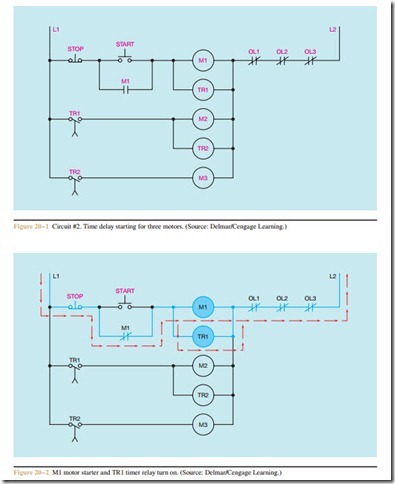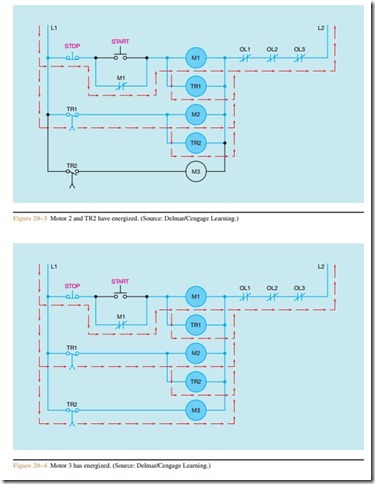TIMED STARTING FOR THREE MOTORS
A machine contains three large motors. The current surge to start all three motors at the same time is too great for the system. Therefore, when the machine is to be started, there must be a delay of 10 seconds be- tween the starting of each motor. Circuit #2, shown in Figure 20 – 1, is a start-stop, push-button control that controls three motor starters and two time-delay relays. The circuit is designed so that an overload on any motor will stop all motors.
When the START button is pressed, a circuit is completed through the START button, M1 motor starter coil, and TR1 relay coil. When coil M1 energizes, motor #1 starts and auxiliary contact M1, which is parallel to the START button, closes. This contact maintains the current flow through the circuit when the START button is released (Figure 20 – 2).
After a 10-second interval, contact TR1 closes. When this contact closes, a circuit is completed through motor starter coil M2 and timer relay coil TR2. When coil M2 energizes, motor #2 starts (Figure 20 – 3).
Ten seconds after coil TR2 energizes, contact TR2 closes. When this contact closes, a circuit is completed to motor starter coil M3, which causes motor #3 to start (Figure 20 – 4).
If the STOP button is pressed, the circuit to coils M1 and TR1 is broken. When motor starter Ml de- energizes, motor #1 stops and auxiliary contact Ml opens. TR1 is an on-delay relay; therefore, when coil TR1 is de-energized, contact TR1 opens immediately.
When contact TR1 opens, motor starter M2 de-energizes, which stops
TR2 opens immediately. This breaks the circuit to motor starter M3. When motor starter M3 de-energizes, motor #3 stops. Although it takes several seconds to explain what happens when the STOP button is pressed, the action of the relays is almost instantaneous. If one of the overload contacts opens while the circuit is energized, the effect is the same as pressing the STOP button. After the circuit stops, all contacts re- turn to their normal positions, and the circuit is the same as the original circuit shown in Figure 20 – 1.
Review Questions
1. Explain the operation of circuit #2 (Figure 20 – 1) if contact M1 did not close.
2. Explain the operation of circuit #2 (Figure 20 – 1) if relay coil TR2 were burned out.
3. Refer to circuit #2, shown in Figure 20–1. Assume that both times are set for a delay of 5 seconds. When the START button is pressed, motor #1 starts running immediately. After a delay of 10 seconds, motor #3 starts running, but motor #2 never starts. Which of the following could cause this problem?
a. TR1 coil is open.
b. M2 starter coil is open.
c. TR2 coil is open.
d. OL2 contact is open.
4. Refer to circuit #2, shown in Figure 20 – 1.
Assume that the timers are set for a delay of 5 sec- onds. When the START button is pressed nothing happens. No motors start running for a period of
1 minute. Which of the following could not cause this problem?
a. M1 holding contacts did not close.
b. the STOP push-button is open.
c. OL1 contact is open.
d. M2 coil is open.
Related posts:
Incoming search terms:
- A motor (M1) must be operated after 30 sec when a Start Push-button (PB1) is pressed Another motor (M2) must be operated 30 sec after the first motor (M1) is started 30 sec after motor (M2) is started motor (M1) must be stopped and 30 sec after motor (M1)
- three motors control circuit operating with time delay
- push button fan runs for 30 seconds circuit
- what is the fault if you press start for motor B and motor A also start same time with motor B
- Plc program for 3 motors starting after 5 sec in manner 1 2 3 and stop after s5 sec in in manner 3 2 1
- two motors start in sequence motor 1 starts immediately when the start button is pressed motor 2 starts five seconds after motor 1 starts
- motor activate delay circuit
- motor a runs first then motor b
- motor A run and must not start before motor motor B must stop first
- when the start botton is activated motors must start rotating
- Motor 1 (M1) starts as soon as the start switch is on; after 10 seconds M1 goes off and motor 2 (M2) starts After 5 seconds M2 goes off and M3 starts After 10 seconds M3 goes off M1 starts and the cycle is
- what is the fault if motor1 starts while motor2 is still running?
- motor sequence motor a must run after 10second motor b dtart
- design a contrll circuit of two motors such that motors m1 runsvby the start push button if m1 stop motor m2 runs for a period
- sequential starting of three motors using electronics
- Design a circuit control when start button pushed a motor will delay to start after sometime it will stop automatically
- draw a ladder diagram for three motor system having following conditions motor 1 is start as soon as start switch is ON after 10 seconds motor 1 goes off and motor 2 starts after 5 second motor goe off
- plc ladder diagram for starting 3 phase motor using star -delta connection
- plc diagram of a generator start on push button after 5 sec motor will star again stop button motor will stop then genwrator stop
- one push button to start a motor 10 sec
- motor 1 starts 10 seconds after motor 2 using same start button
- motor start after 10 sec and run for 5 sec circuit diagram
- motor A start before motor B after 10 sec motor B start
- one motor start from 3 buuton#spf=1
- one button press one motor start and after sometime second motor on and second motor on immediately first motor off program in plc
- motor m2 can only be stared 10 seconds after motor m1
- motor one must start before motor 2 can only start after 5 second motor 1 motor 2 can stop and start without affecting motor 1 of motor 1 stop and start Mic also stop emergency stop must stop both
- motor1 starts after 10sec motor 2starts then after 10 sec motor3starts similarly it stops respectively
- motor start after between interval of 10 seconds
- long form of vpn
- ladder two motors m1 and m2 when run switch is operated both motors must start afer 4 minutes motor 1 must stop m2 switches off after 2 minutes
- Design a control circuit to fulfill the following conditions
- can u teach me the better way to understand seguence of control circuit when press start button after 10 second motor A rotates after 10 second motorB start press stop button both motors stop B
- design a circuit - when the start button is activated motor M1 must start rotating only after ten seconds motor M2 can be started by activating the same start button motor M1 must keep on rotating ten second after motor M2 has started rotating both the mo
- control circuit when the start button us activated motor 1 must start rotating ten seconds after motor1 has started rotating motor 2 must start rotating and motor m1 must stop rotating automatically ten seconds after motor 2 has started it must sto automa
- control circuit of 2 motor which one will stop after ten seconds of other stop
- when you press start nothing happens only after 10minutes there is a reaction
- best delay starting motors
- an electric motor runs for 12seconds and ingages other one to runs for 2 seconds and stops automatically
- develop wiring of three motors m1 m2 and m3
- diagram where motor one must start befor motor two when motor one isa running motor 2 can be started
- drawing of :the motors must not be on simultaneously when the start button is pressed only motor A must start after 10 seconds the timer myst switch off motor A and switch on motor B
- ladder diagram with 2 start stop PB in two different station without auxiliary
- is there any motor which starter for 1 sec and stop in 1 sec
- How-to-draw-a-circuit-When-the-start-button-is-activated-motor1-and-motor2-must-start-rotatiting ten-second-after-2motors-started-rotating-motor1-must-stop-rotating-automatically-ten-second-after-motor1-stopped-rotating motor2-must-stop-rotating-automatic
- how to start two motors using one start button
- how to start 3motors start by one start pushbotton
- how to run 2 motors with 1 start button after 10 seconds
- how to control amotor with timer stoping and starting automatically
- given 1 start button and two motor you press the start button the first time then motor 1 runs you press the same start button then the second motor runs

